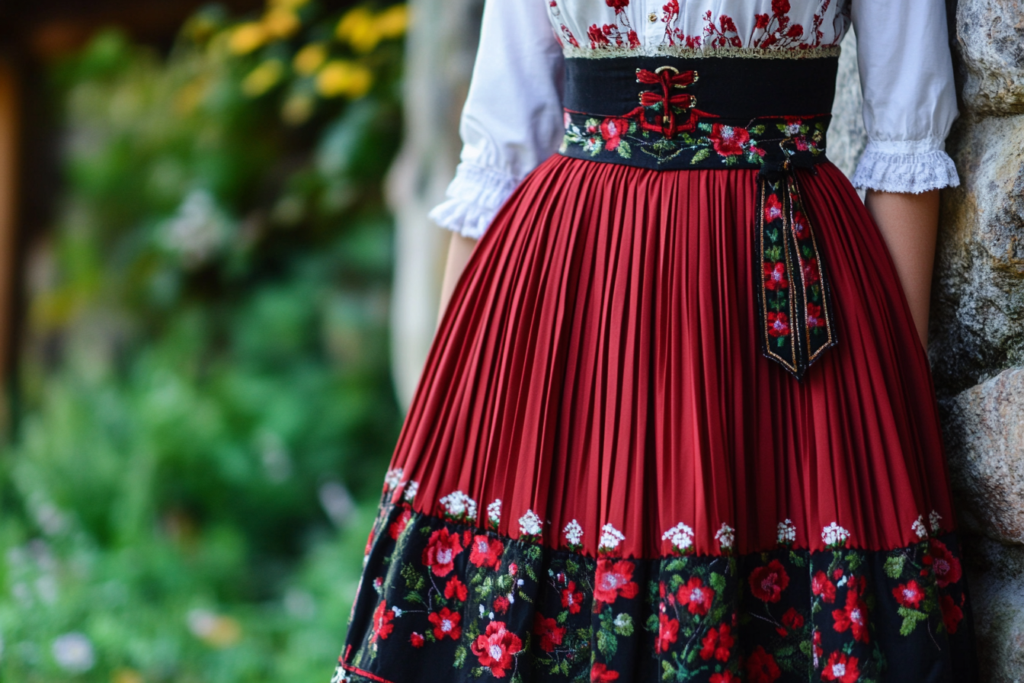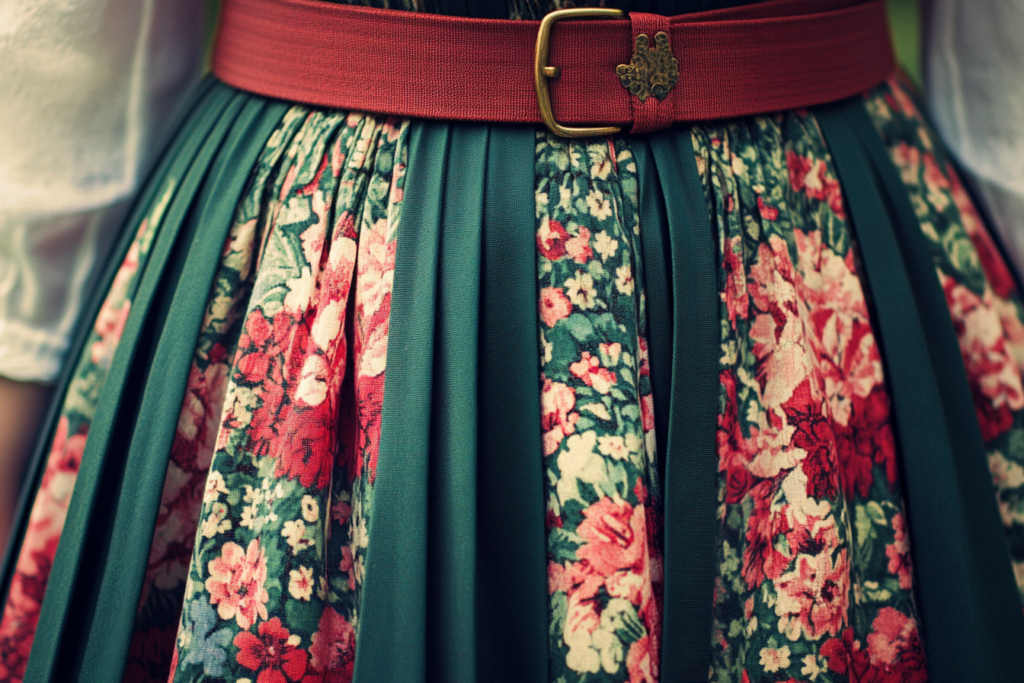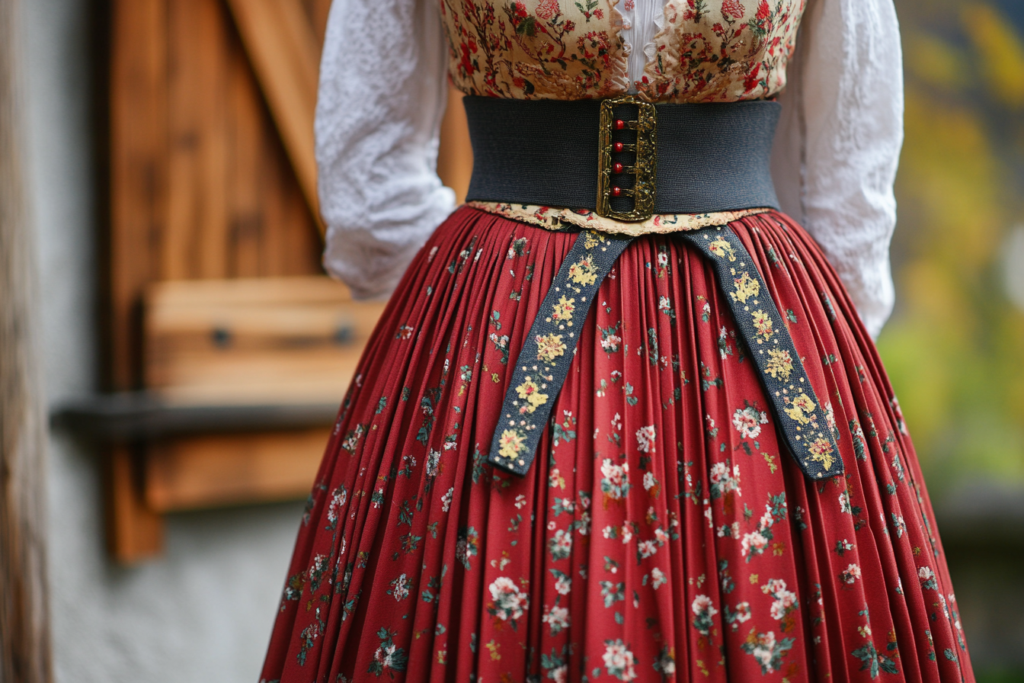Introduction: What is a Dirndl Skirt?
The dirndl skirt is a classic and iconic garment often associated with traditional Bavarian and Alpine clothing. Characterized by its pleated design and a straight belt that fastens at the waist, this skirt is a key component of the dirndl dress. Originally worn as everyday attire by women in the regions of Bavaria, Austria, and Switzerland, the dirndl skirt has now become a symbol of cultural heritage and is frequently worn at festivals like Oktoberfest, as well as in modern fashion adaptations.
With its elegant silhouette and historical significance, the dirndl skirt is a timeless piece that has evolved from traditional folk clothing to a contemporary fashion statement.


Design and Structure of the Dirndl Skirt
- Pleated Fabric:
- The defining feature of the dirndl skirt is its pleating, which adds volume and creates a full, flattering shape. The pleats are usually evenly spaced, running from the waist down to the hem. The pleating technique is a crucial design element, allowing the skirt to maintain its structure and flow. Traditionally, the pleats are stitched down at the waistband to hold their shape.
- Straight Waist Belt:
- The dirndl skirt is fastened at the waist with a straight belt, typically made from the same fabric as the skirt or a complementary material. The belt is tied tightly around the waist, giving the garment its fitted appearance at the top while allowing the pleats to flare out below. The belt adds an element of structure and accentuates the waistline, making the dirndl skirt both practical and flattering.
- Length and Styling:
- Traditionally, the dirndl skirt falls to the knee or just below it, making it appropriate for both formal and casual occasions. The skirt is often paired with a matching blouse or top, which can vary in style depending on the specific occasion. For a more festive look, the dirndl skirt is sometimes styled with a corset or apron.
History and Cultural Significance of the Dirndl Skirt
- Traditional Bavarian and Alpine Wear:
- The dirndl originated as a practical and humble garment worn by women in the Alpine regions of Europe, particularly in Bavaria and Austria, during the 19th century. It was originally a type of peasant dress, designed to be functional and easy to wear while doing daily chores or working on farms. Over time, the dirndl became more decorative and evolved into a popular garment worn at festivals and cultural celebrations.
- The Dirndl at Oktoberfest:
- Today, the dirndl skirt is most commonly seen at Oktoberfest, an annual beer festival held in Munich, Germany. At Oktoberfest, women wear the full dirndl dress, which includes the pleated skirt, a blouse, a corset, and an apron. The dirndl has become a symbol of Bavarian culture and is worn proudly by both locals and tourists alike. The skirt, with its vibrant patterns and rich fabric, stands out as a key part of the outfit.
- Modern Adaptations:
- While the dirndl skirt remains deeply rooted in tradition, it has also been embraced by modern fashion designers, who often create contemporary versions of the skirt for casual and formal wear. Designers may use fabrics like denim, velvet, or satin, and update the pleating or belt design to suit modern tastes while preserving the essence of the traditional dirndl skirt.
How to Wear a Dirndl Skirt
- Pairing with the Right Top:
- To wear a dirndl skirt, the ideal top is a fitted blouse, often with puffed sleeves and lace or ribbon details. A tight-fitting corset or bodice can also be worn over the blouse for a more structured look. The blouse should complement the skirt’s color and style, creating a cohesive and flattering ensemble.
- Adding an Apron:
- An apron is a common accessory worn with the dirndl skirt. Traditionally, aprons are made from the same fabric as the skirt and are tied at the waist, adding an extra layer of detail to the outfit. The apron also serves a practical function by protecting the skirt from dirt or spills.
- Footwear Choices:
- The right footwear is essential to complete the dirndl skirt outfit. Traditional footwear includes sturdy shoes or boots, which are practical for walking and standing for long periods, especially at festivals. However, modern adaptations may feature sandals or ballet flats for a more contemporary look.
- Accessorizing:
- Accessories can make a dirndl skirt outfit stand out. Traditional jewelry, such as silver or gold necklaces, and hair accessories like ribbons or flowers, are often worn to enhance the overall look. A hat or headpiece may also be added for an extra touch of tradition.
The Dirndl Skirt in Contemporary Fashion
- Fashion Runways:
- Designers have continued to experiment with the dirndl skirt, incorporating it into haute couture and casual fashion collections. The pleated skirt, once considered purely traditional, is now seen in modern collections, where it’s styled in various ways, from elegant evening wear to casual day dresses.
- Influence on Global Fashion:
- The dirndl skirt has had a broader influence on global fashion, especially in the context of fusion wear. It’s often combined with contemporary fabrics and styling to create versatile, multicultural looks. The popularity of folk-inspired fashion has helped bring the dirndl skirt back into the spotlight, allowing it to be embraced by younger generations who are seeking to connect with traditional heritage while adding a modern twist.
- Sustainable Fashion:
- The dirndl skirt also aligns with the growing trend of sustainable fashion. Its timeless design, emphasis on craftsmanship, and use of natural fabrics like cotton and wool make it a suitable choice for eco-conscious consumers. Vintage dirndls, often passed down through generations, contribute to the sustainable fashion movement by encouraging the reuse and recycling of garments.
Conclusion: Why the Dirndl Skirt is Timeless
The dirndl skirt remains a beloved piece of cultural heritage, representing the spirit of the Bavarian and Alpine regions while transcending traditional fashion. Its elegant pleats, functional design, and versatile wearability ensure that it continues to be relevant in both traditional and contemporary settings. Whether worn at a festival, in a modern fashion collection, or as a nod to heritage, the dirndl skirt will always have a place in the fashion world.



